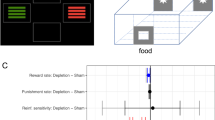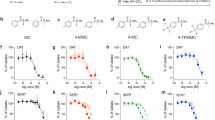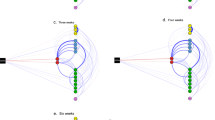Abstract
Central serotonin (5-HT) function is thought to be a critical component of behavioral inhibition and impulse control. However, in recent clinical studies, 5-HT manipulations failed to affect stop-signal reaction time (SSRT), which is a fundamental process in behavioral inhibition. We investigated the effect of central 5-HT depletion (intracerebroventricular 5,7-dihydroxytryptamine) in rats on two aspects of behavioral inhibition, SSRT and ‘waiting’, using the stop-signal task. 5-HT depletion had no effects on SSRT or any other primary measure on the stop-signal task. However, within the same task, there was a deficit in ‘waiting’ in 5-HT-depleted rats when they were required to withhold from responding in the terminal element of the stop-signal task for an extended period. D-Amphetamine had dose-dependent, but not 5-HT-dependent effects on SSRT. Conversely, the dose that tended to improve, or decrease, SSRT (0.3 mg/kg) impaired the ability to wait, again independently of 5-HT manipulation. These findings suggest that SSRT and ‘waiting’ are distinct measures of behavioral inhibition, and show that 5-HT is critical for some forms of behavioral inhibition but not others. This has significant implications for the treatment of conditions such as attention deficit and hyperactivity disorder, substance abuse, and affective disorders, in which inhibitory and impulse-control deficits are common.
Similar content being viewed by others
Log in or create a free account to read this content
Gain free access to this article, as well as selected content from this journal and more on nature.com
or
References
Aron AR, Poldrack RA (2005). The cognitive neuroscience of response inhibition: relevance for genetic research in attention-deficit/hyperactivity disorder. Biol Psychiatry 57: 1285–1292.
Asgari K, Body S, Zhang Z, Fone KC, Bradshaw CM, Szabadi E (2006). Effects of 5-HT1A and 5-HT2A receptor stimulation on temporal differentiation performance in the fixed-interval peak procedure. Behav Processes 71: 250–257.
Bellgrove MA, Chambers CD, Vance A, Hall N, Karamitsios M, Bradshaw JL (2006). Lateralized deficit of response inhibition in early-onset schizophrenia. Psychol Med 36: 495–505.
Bizot J, Le Bihan C, Puech AJ, Hamon M, Thiebot M (1999). Serotonin and tolerance to delay of reward in rats. Psychopharmacology (Berl) 146: 400–412.
Bjorkland A, Baumgarten HD, Rensch A (1975). 5,7-Dihydroxytryptamine: improvement of its selectivity for serotonin neurons in the CNS by treatment with desipramine. J Neurochem 24: 833–835.
Body S, Kheramin S, Ho MY, Miranda F, Bradshaw CM, Szabadi E (2003). Effects of a 5-HT2 receptor agonist, DOI (2,5-dimethoxy-4-iodoamphetamine), and antagonist, ketanserin, on the performance of rats on a free-operant timing schedule. Behav Pharmacol 14: 599–607.
Cardinal RN, Aitken MRF (2001). Whisker, version 2.2, computer software. http://www.whiskercontrol.com
Carli M, Baviera M, Invernizzi RW, Balducci C (2006). Dissociable contribution of 5-HT1A and 5-HT2A receptors in the medial prefrontal cortex to different aspects of executive control such as impulsivity and compulsive perseveration in rats. Neuropsychopharmacology 31: 757–767.
Carli M, Samanin R (2000). The 5-HT(1A) receptor agonist 8-OH-DPAT reduces rats' accuracy of attentional performance and enhances impulsive responding in a five-choice serial reaction time task: role of presynaptic 5-HT(1A) receptors. Psychopharmacology (Berl) 149: 259–268.
Chamberlain SR, Blackwell AD, Fineberg NA, Robbins TW, Sahakian BJ (2005). The neuropsychology of obsessive compulsive disorder: the importance of failures in cognitive and behavioural inhibition as candidate endophenotypic markers. Neurosci Biobehav Rev 29: 399–419.
Chamberlain SR, Muller U, Blackwell AD, Clark L, Robbins TW, Sahakian BJ (2006). Neurochemical modulation of response inhibition and probabilistic learning in humans. Science 311: 861–863.
Chiang TJ, Al-Ruwaitea AS, Ho MY, Bradshaw CM, Szabadi E (1999). Effect of central 5-hydroxytryptamine depletion on performance in the free-operant psychophysical procedure: facilitation of switching, but no effect on temporal differentiation of responding. Psychopharmacology (Berl) 143: 166–173.
Clark L, Cools R, Robbins TW (2004). The neuropsychology of ventral prefrontal cortex: decision-making and reversal learning. Brain Cogn 55: 41–53.
Clark L, Roiser JP, Cools R, Rubinsztein DC, Sahakian BJ, Robbins TW (2005). Stop signal response inhibition is not modulated by tryptophan depletion or the serotonin transporter polymorphism in healthy volunteers: implications for the 5-HT theory of impulsivity. Psychopharmacology (Berl) 182: 570–578.
Clarke HF, Walker SC, Crofts HS, Dalley JW, Robbins TW, Roberts AC (2005). Prefrontal serotonin depletion affects reversal learning but not attentional set shifting. J Neurosci 25: 532–538.
Crean J, Richards JB, de Wit H (2002). Effect of tryptophan depletion on impulsive behavior in men with or without a family history of alcoholism. Behav Brain Res 136: 349–357.
Dalen L, Sonuga-Barke EJ, Hall M, Remington B (2004). Inhibitory deficits, delay aversion and preschool AD/HD: implications for the dual pathway model. Neural Plast 11: 1–11.
Dalley JW, Fryer TD, Brichard L, Robinson ES, Theobald DE, Laane K et al (2007). Nucleus accumbens D2/3 receptors predict trait impulsivity and cocaine reinforcement. Science 315: 1267–1270.
Dalley JW, Mar AC, Economidou D, Robbins TW (2008). Neurobehavioral mechanisms of impulsivity: fronto-striatal systems and functional neurochemistry. Pharmacol Biochem Behav 90: 250–260.
de Wit H, Crean J, Richards JB (2000). Effects of D-amphetamine and ethanol on a measure of behavioral inhibition in humans. Behav Neurosci 114: 830–837.
de Wit H, Enggasser JL, Richards JB (2002). Acute administration of D-amphetamine decreases impulsivity in healthy volunteers. Neuropsychopharmacology 27: 813–825.
Dougherty DM, Marsh DM, Mathias CW, Dawes MA, Bradley DM, Morgan CJ et al (2007). The effects of alcohol on laboratory-measured impulsivity after L-tryptophan depletion or loading. Psychopharmacology (Berl) 193: 137–150.
Eagle DM, Bari A, Robbins TW (2008). The neuropsychopharmacology of action inhibition: cross-species translation of the stop-signal and go/no-go tasks. Psychopharmacology (Berl) 199: 439–456.
Eagle DM, Robbins TW (2003a). Inhibitory control in rats performing a stop-signal reaction-time task: effects of lesions of the medial striatum and D-amphetamine. Behav Neurosci 117: 1302–1317.
Eagle DM, Robbins TW (2003b). Lesions of the medial prefrontal cortex or nucleus accumbens core do not impair inhibitory control in rats performing a stop-signal reaction time task. Behav Brain Res 146: 131–144.
Evenden JL (1999). Varieties of impulsivity. Psychopharmacology 146: 348–361.
Feola TW, de Wit H, Richards JB (2000). Effects of D-amphetamine and alcohol on a measure of behavioral inhibition in rats. Behav Neurosci 114: 838–848.
Fillmore MT, Rush CR (2002). Impaired inhibitory control of behavior in chronic cocaine users. Drug Alcohol Depend 66: 265–273.
Fletcher PJ (1995). Effects of combined or separate 5,7-dihydroxytryptamine lesions of the dorsal and median raphe nuclei on responding maintained by a DRL 20s schedule of food reinforcement. Brain Res 675: 45–54.
Gately PF, Poon SL, Segal DS, Geyer MA (1985). Depletion of brain serotonin by 5,7-dihydroxytryptamine alters the response to amphetamine and the havituation of locomotor activity in rats. Psychopharmacology (Berl) 87: 400–405.
Gauggel S, Rieger M, Feghoff TA (2004). Inhibition of ongoing responses in patients with Parkinson's disease. J Neurol Neurosurg Psychiatry 75: 539–544.
Harrison AA, Everitt BJ, Robbins TW (1997). Central 5-HT depletion enhances impulsive responding without affecting the accuracy of attentional performance: interactions with dopaminergic mechanisms. Psychopharmacology (Berl) 133: 329–342.
Harrison AA, Everitt BJ, Robbins TW (1999). Central serotonin depletion impairs both the acquisition and performance of a symmetrically reinforced go/no-go conditional visual discrimination. Behav Brain Res 100: 99–112.
Ho MY, Velazquez-Martinez DN, Bradshaw CM, Szabadi E (2002). 5-Hydroxytryptamine and interval timing behaviour. Pharmacol Biochem Behav 71: 773–785.
Howell DC (1997). Statistical Methods for Psychology, 4th edn. Duxbury Press: Belmont, CA.
Linnoila M, Virkkunen M, Scheinin M, Nuutila A, Rimon R, Goodwin FK (1983). Low cerebrospinal fluid 5-hydroxyindoleacetic acid concentration differentiates impulsive from nonimpulsive violent behavior. Life Sci 33: 2609–2614.
Logan GD, Cowan WB (1984). On the ability to inhibit thought and action—a theory of an act of control. Psychol Rev 91: 295–327.
Masaki D, Yokoyama C, Kinoshita S, Tsuchida H, Nakatomi Y, Yoshimoto K et al (2006). Relationship between limbic and cortical 5-HT neurotransmission and acquisition and reversal learning in a go/no-go task in rats. Psychopharmacology (Berl) 189: 249–258.
Matthews K, Dalley JW, Matthews C, Tsai TH, Robbins TW (2001). Periodic maternal separation of neonatal rats produces region- and gender-specific effects on biogenic amine content in postmortem adult brain. Synapse 40: 1–10.
Mobini S, Chiang TJ, Al-Ruwaitea AS, Ho MY, Bradshaw CM, Szabadi E (2000a). Effect of central 5-hydroxytryptamine depletion on inter-temporal choice: a quantitative analysis. Psychopharmacology (Berl) 149: 313–318.
Mobini S, Chiang TJ, Ho MY, Bradshaw CM, Szabadi E (2000b). Effects of central 5-hydroxytryptamine depletion on sensitivity to delayed and probabilistic reinforcement. Psychopharmacology (Berl) 152: 390–397.
Monterosso JR, Aron AR, Cordova X, Xu J, London ED (2005). Deficits in response inhibition associated with chronic methamphetamine abuse. Drug Alcohol Depend 79: 273–277.
Oosterlaan J, Logan GD, Sergeant JA (1998). Response inhibition in AD/HD, CD, comorbid AD/HD+CD, anxious, and control children: a meta-analysis of studies with the stop task. J Child Psychol Psychiatry 39: 411–425.
Passetti F, Dalley JW, Robbins TW (2003). Double dissociation of serotonergic and dopaminergic mechanisms on attentional performance using a rodent five-choice reaction time task. Psychopharmacology (Berl) 165: 136–145.
Pattij T, Vanderschuren LJ (2008). The neuropharmacology of impulsive behaviour. Trends Pharmacol Sci 29: 192–199.
Paxinos G, Watson C (1986). The Rat Brain in Stereotaxic Coordinates, 2nd edn. Academic Press: New York.
Penades R, Catalan R, Rubia K, Andres S, Salamero M, Gasto C (2007). Impaired response inhibition in obsessive compulsive disorder. Eur Psychiatry 22: 404–410.
Reynolds B, Penfold RB, Patak M (2008). Dimensions of impulsive behavior in adolescents: laboratory behavioural assessments. Exp Clin Psychopharmacol 16: 124–131.
Robinson ES, Dalley JW, Theobald DE, Glennon JC, Pezze MA, Murphy ER et al (2007). Opposing roles for 5-HT(2A) and 5-HT(2C) receptors in the nucleus accumbens on inhibitory response control in the 5-choice serial reaction time task. Neuropsychopharmacology 33: 2398–2406.
Robinson ES, Eagle DM, Mar AC, Bari A, Banerjee G, Jiang X et al (2008). Similar effects of the selective noradrenaline reuptake inhibitor atomoxetine on three distinct forms of impulsivity in the rat. Neuropsychopharmacology 33: 1028–1037.
Rubia K, Smith A, Taylor E (2007). Performance of children with attention deficit hyperactivity disorder (ADHD) on a test battery of impulsiveness. Child Neuropsychol 13: 276–304.
Ruotsalainen S, MacDonald E, Miettinen R, Puumala T, Riekkinen Sr P, Sirvio J (1997). Additive deficits in the choice accuracy of rats in the delayed non-matching to position task after cholinolytics and serotonergic lesions are non-mnemonic in nature. Psychopharmacology (Berl) 130: 303–312.
Schachar R, Tannock R, Marriott M, Logan G (1995). Deficient inhibitory control in attention deficit hyperactivity disorder. J Abnorm Child Psychol 23: 411–437.
Schweighofer N, Bertin M, Shishida K, Okamoto Y, Tanaka SC, Yamawaki S et al (2008). Low-serotonin levels increase delayed reward discounting in humans. J Neurosci 28: 4528–4532.
Sonuga-Barke EJ (2003). The dual pathway model of AD/HD: an elaboration of neuro-developmental characteristics. Neurosci Biobehav Rev 27: 593–604.
Soubrié P (1986). Reconciling the role of central serotonin neurons in human and animal behavior. Behav Brain Sci 9: 319–364.
Talpos JC, Wilkinson LS, Robbins TW (2006). A comparison of multiple 5-HT receptors in two tasks measuring impulsivity. J Psychopharmacol 20: 47–58.
Tanaka SC, Schweighofer N, Asahi S, Shishida K, Okamoto Y, Yamawaki S et al (2007). Serotonin differentially regulates short- and long-term prediction of rewards in the ventral and dorsal striatum. PLoS ONE 2: e1333.
van den Wildenberg WP, van Boxtel GJ, van der Molen MW, Bosch DA, Speelman JD, Brunia CH (2006). Stimulation of the subthalamic region facilitates the selection and inhibition of motor responses in Parkinson's disease. J Cogn Neurosci 18: 626–636.
Walderhaug E, Landro NI, Magnusson A (2008). A synergic effect between lowered serotonin and novel situations on impulsivity measured by CPT. J Clin Exp Neuropsychol 30 (2): 204–211.
Walderhaug E, Lunde H, Nordvik JE, Landro NI, Refsum H, Magnusson A (2002). Lowering of serotonin by rapid tryptophan depletion increases impulsiveness in normal individuals. Psychopharmacology (Berl) 164: 385–391.
Ward BO, Wilkinson LS, Robbins TW, Everitt BJ (1999). Forebrain serotonin depletion facilitates the acquisition and performance of a conditional visual discrimination task in rats. Behav Brain Res 100: 51–65.
Williams JH, Meara JR, Azmitia EC (1990). Effects of 5,7-dihydroxytryptamine injections in the fornix-fimbria on locomotor activity in photocell cages and the open field. Behav Brain Res 40: 37–44.
Winstanley CA, Dalley JW, Theobald DE, Robbins TW (2003). Global 5-HT depletion attenuates the ability of amphetamine to decrease impulsive choice on a delay-discounting task in rats. Psychopharmacology (Berl) 170: 320–331.
Winstanley CA, Dalley JW, Theobald DE, Robbins TW (2004a). Fractionating impulsivity: contrasting effects of central 5-HT depletion on different measures of impulsive behavior. Neuropsychopharmacology 29: 1331–1343.
Winstanley CA, Eagle DM, Robbins TW (2006). Behavioral models of impulsivity in relation to ADHD: translation between clinical and preclinical studies. Clin Psychol Rev 26: 379–395.
Winstanley CA, Theobald DE, Dalley JW, Glennon JC, Robbins TW (2004b). 5-HT2A and 5-HT2C receptor antagonists have opposing effects on a measure of impulsivity: interactions with global 5-HT depletion. Psychopharmacology (Berl) 176: 376–385.
Wittmann M, Carter O, Hasler F, Cahn BR, Grimberg U, Spring P et al (2007). Effects of psilocybin on time perception and temporal control of behaviour in humans. J Psychopharmacol 21: 50–64.
Wogar MA, Bradshaw CM, Szabadi E (1992). Impaired acquisition of temporal differentiation performance following lesions of the ascending 5-hydroxytryptaminergic pathways. Psychopharmacology (Berl) 107: 373–378.
Wogar MA, Bradshaw CM, Szabadi E (1993). Effect of lesions of the ascending 5-hydroxytryptaminergic pathways on choice between delayed reinforcers. Psychopharmacology (Berl) 111: 239–243.
Zepf FD, Holtmann M, Stadler C, Demisch L, Schmitt M, Wockel L et al (2008). Diminished serotonergic functioning in hostile children with ADHD: tryptophan depletion increases behavioural inhibition. Pharmacopsychiatry 41: 60–65.
Acknowledgements
This study was supported by a Wellcome Trust Programme Grant (076274/z/04/z) awarded to TWR, BJ Everitt, BJ Sahakian, and AC Roberts and completed within the University of Cambridge Behavioral and Clinical Neuroscience Institute, supported by a joint award from the Medical Research Council and the Wellcome Trust. OL was supported by a Marie Curie Fellowship. YP was supported by a predoctoral Formaci?n Investigadora scholarship from Generalitat de Catalunya.
Author information
Authors and Affiliations
Corresponding author
Additional information
DISCLOSURE/CONFLICT OF INTEREST
TWR discloses consultancy for Cambridge Cognition, Eli Lilly Inc., Wyeth, GlaxoSmithKline, and Allon Therapeutics, receives grant/research support from Pfizer, GlaxoSmithKline, and is a major stock shareholder in CeNeS, Cambridge Cognition, Allon Therapeutics. DME, OL, DEHT, YP, RZ, RG, and JWD have no disclosures.
Supplementary Information accompanies the paper on the Neuropsychopharmacology website (http://www.nature.com/npp)
Supplementary information
Rights and permissions
About this article
Cite this article
Eagle, D., Lehmann, O., Theobald, D. et al. Serotonin Depletion Impairs Waiting but not Stop-Signal Reaction Time in Rats: Implications for Theories of the Role of 5-HT in Behavioral Inhibition. Neuropsychopharmacol 34, 1311–1321 (2009). https://doi.org/10.1038/npp.2008.202
Received:
Revised:
Accepted:
Published:
Issue date:
DOI: https://doi.org/10.1038/npp.2008.202
Keywords
This article is cited by
-
Neuromodulation of prefrontal cortex cognitive function in primates: the powerful roles of monoamines and acetylcholine
Neuropsychopharmacology (2022)
-
Convergent neural connectivity in motor impulsivity and high-fat food binge-like eating in male Sprague-Dawley rats
Neuropsychopharmacology (2019)
-
Effects of amphetamine, methylphenidate, atomoxetine, and morphine in rats responding under an adjusting stop signal reaction time task
Psychopharmacology (2019)
-
Biphasic effects of 5-HT1A agonism on impulsive responding are dissociable from effects on anxiety in the variable consecutive number task
Naunyn-Schmiedeberg's Archives of Pharmacology (2019)
-
The neurobiology of impulse control disorders in Parkinson’s disease: from neurotransmitters to neural networks
Cell and Tissue Research (2018)



